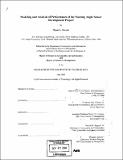Modeling and analysis of performance of the steering angle sensor development project
Author(s)
Hurtado, Miguel A. (Miguel Angel), 1968-
DownloadFull printable version (15.41Mb)
Other Contributors
Sloan School of Management.
Advisor
John J. Deyst, Jr. and Steven D. Eppinger.
Terms of use
Metadata
Show full item recordAbstract
In the highly competitive automotive industry, OEM and tier-I suppliers face the problem of determining costs and creating accurate and rapid schedules for current and future product developments. Successful companies in this industry are those that are able to forecast and meet important deadlines, satisfy performance requirements and reduce costs to keep development within budget. But frequently one or two factors are achieved at the expense of the others. Sometimes, for example, suppliers are able to cut costs, but only at the expense of quality. Or they can increase quality at expense of costs. Both scenarios are of concern, especially when competitors are attempting to capture market share. Engineers and program managers require powerful techniques to have better estimates of completion time versus expenditures. Unfortunately, though, there are not yet such tools available that are capable of incorporating both dimensions of product quality and cost. Moreover, it would be desirable to incorporate product performance with those two dimensions in order to obtain a broad perspective of the entire design. The main goal of this thesis is the investigation, evaluation and application of the research reported in the Ph.D. thesis "Modeling and Analyzing Cost, Schedule, and Performance in Complex System Product Development" (Browning 1998) in two product platforms of Valeo, Electronics. The two product platforms selected for this purpose were the steering angle sensor (SAS) and the ultrasonic park assist sensor (UPAS). The research for this project was conducted at Valeo, Electronics, located in Bietigheim-Bissingen, Germany. First, data were collected concerning development costs, timing and performance of the steering angle sensor. Second, the software was modified and applied to obtain a joint probability distribution of cost and schedule for this platform. Third, the model was tracked and validated. The tracking of the model was performed within the same platform by running the software at various times. The validation of the model consisted of applying the same methodology for the UPAS and other areas of the SAS. Monte Carlo simulation, optimization, design structure matrices, feedback among activities, and concurrency in product development systems, along with three software tools (Visual Basic, Excel and MATLAB) were used extensively in this work. Finally, the model and the results were presented to the company, with recommendations for future applications.
Description
Thesis (S.M.)--Massachusetts Institute of Technology, Dept. of Aeronautics and Astronautics; and, (S.M.)--Massachusetts Institute of Technology, Sloan School of Management, 2000. Also available online at the MIT Theses Online homepage <http://thesis.mit.edu>. Includes bibliographical references (leaf 83).
Date issued
2000URI
http://theses.mit.edu/Dienst/UI/2.0/Describe/0018.mit.theses%2f2000-31http://hdl.handle.net/1721.1/9254
Department
Massachusetts Institute of Technology. Department of Aeronautics and Astronautics; Sloan School of ManagementPublisher
Massachusetts Institute of Technology
Keywords
Aeronautics and Astronautics., Sloan School of Management.